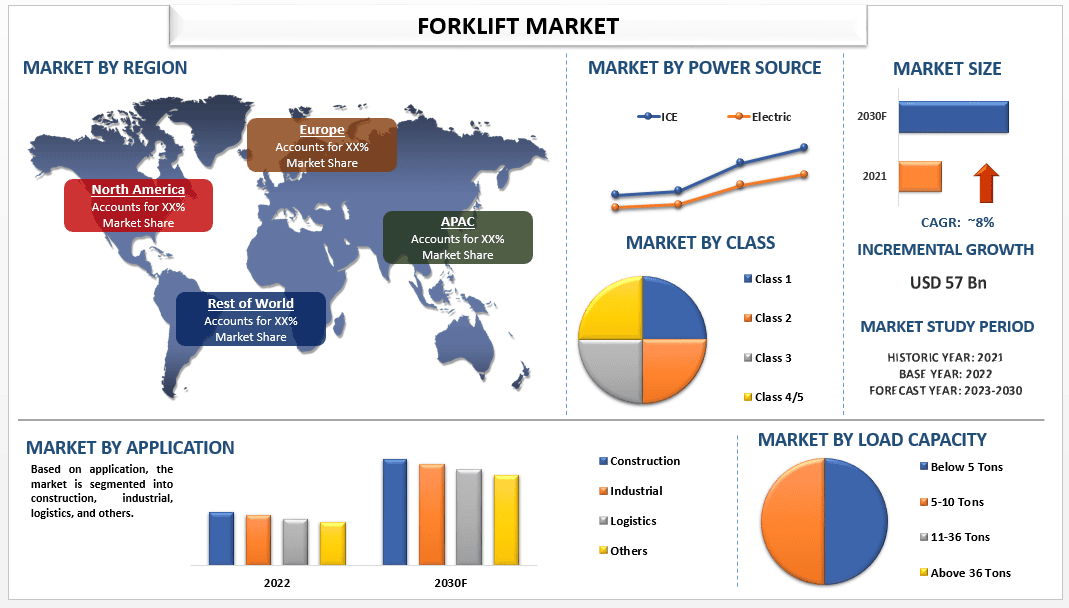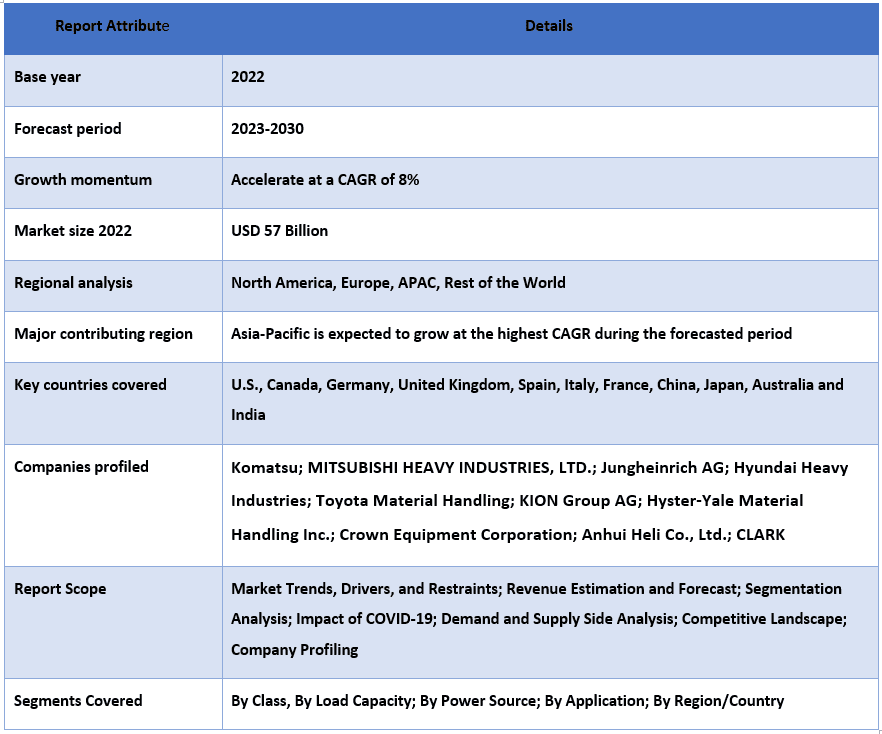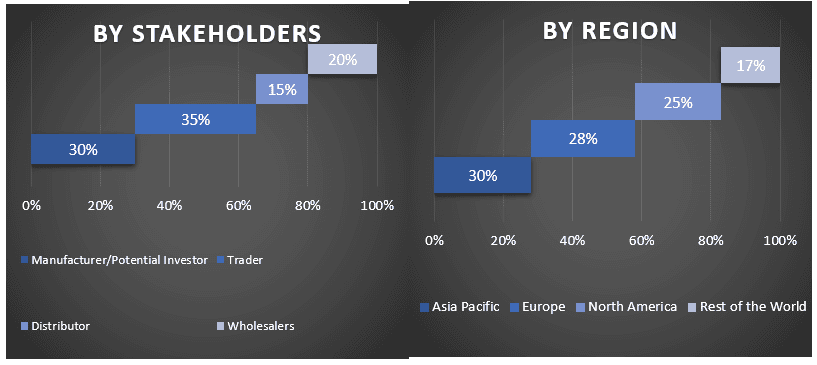- Home
- About Us
- Industry
- Services
- Reading
- Contact Us
Global Forklift Market: Current Analysis and Forecast (2023-2030)
Emphasis on into Class (Class 1, Class 2, Class 3 and Class 4/5); Load Capacity (Below 5 Tons, 5-10 Tons, 11-36 Tons, and Above 36 Tons); Power Source (ICE and Electric); Application (Construction, Industrial, Logistics and others); and Region/Country.

Forklift Market was Valued at USD 57 Billion is expected to grow at a CAGR of around 8% over the forecast period (2023-2030). The expanding construction industry globally will spur the demand for robust forklifts that can be employed in harsh outdoor environments. Several government organizations are focusing on boosting the existing infrastructure for overall economic development. For instance, in May 2023 the South African Government aims to spend USD 56 billion (R900 billion) by 2027 on the country’s transportation infrastructure. Such large-scale construction projects will propel the demand for forklifts that ensure the fast transfer of heavy materials. The e-commerce market has witnessed growth as people preferred online shopping to reduce over-crowding in retail stores and to ensure social distancing. This will boost the demand for forklifts from the e-commerce sector, as online retailers employ high-quality forklifts in distribution facilities to streamline material handling operations. If e-commerce is booming and the number of packages shipped is growing, the logistics industry will continue to grow. On an estimate, the global logistics industry is worth over USD 9 trillion. In recent times, significant growth has been observed owing to the demand for modern material handling equipment. The forklifts are used for lifting the material and used for monitoring and tracking the performance of the operator and monitoring the mechanical and power systems. As a result, with the adoption of advanced technology, there are substantial market opportunities, owing to the manufacturers’ efforts in manufacturing of these trucks that are technologically driven.
Some of the major players operating in the market include Komatsu; MITSUBISHI HEAVY INDUSTRIES, LTD.; Jungheinrich AG; Hyundai Heavy Industries; Toyota Material Handling; KION Group AG; Hyster-Yale Material Handling Inc.; Crown Equipment Corporation; Anhui Heli Co., Ltd.; CLARK. Several M&A’s along with partnerships have been undertaken by these players to boost their presence in different regions.
Insights Presented in the Report
“Amongst Class, The class 2 segment dominated the market with the largest market share in 2022”
Based on Class, the market is segmented into Class 1, Class 2, Class 3, and Class 4/5. The class 2 segment dominated the market with the largest market share in 2022. This growth is attributed to the increasing number of storage facilities & warehouses. Class 2 forklifts are electric, narrow aisle models. Moreover, the class 2 forklifts are designed with maneuverability that permits them to operate in tight spaces & narrow aisles. Further, by 2030, the class 3 segment will likely dominate the market due to the increasing demand from small and medium-sized warehouses for unloading and loading materials.
“Amongst Load Capacity, 5-10 ton segment accounted for the largest market share in 2022”
Based on load capacity, the market is segmented into below 5 tons, 5-10 tons, 11-36 tons, and above 36 tons. The 5-10 ton segment accounted for the largest market share in 2022. These forklifts are used for handling a wide range of materials, including steel, pallets, and bricks. The segment’s growth is attributed to the development of industrial sectors, including warehousing & logistics, and manufacturing. These forklifts can be used indoors or outdoors and are fueled by natural gas, liquid propane, or gasoline.
Forklift Market Report Coverage

“Asia Pacific is expected to lead the forklift market during the forecasted period”
Asia Pacific is expected to lead the forklift market during the forecasted period. Due to the increasing inclination of manufacturers toward plant automation. Moreover, the increasing R&D investment for developing new automotive types, the favorable economic environment, and the need for technological advancements in in-house logistics are also helping to boost the market growth in this region. Growth in the area is also driven by the demand for state-of-the-art material processing equipment in industries such as construction, mining, food, and beverages. In addition, the deployment of technology-savvy vehicles in the region has gained maximum traction and is complementing the growth of the truck industry. For instance, In June 2022, Mitsubishi Logisnext launched the MX2 and MXL Series 4-wheel electric pneumatic forklifts with 5,000-7,000 and 9,000-12,000 lb capacities.
Reasons to buy this report:
- The study includes market sizing and forecasting analysis validated by authenticated key industry experts.
- The report presents a quick review of overall industry performance at one glance.
- The report covers an in-depth analysis of prominent industry peers with a primary focus on key business financials, product portfolios, expansion strategies, and recent developments.
- Detailed examination of drivers, restraints, key trends, and opportunities prevailing in the industry.
- The study comprehensively covers the market across different segments.
- Deep dive regional level analysis of the industry.
Customization Options:
The forklift market can further be customized as per the requirement or any other market segment. Besides this, UMI understands that you may have your own business needs, hence feel free to connect with us to get a report that completely suits your requirements.
Table of Content
Research Methodology for the Forklift Market Analysis (2023-2030)
Analyzing the historical market, estimating the current market, and forecasting the future market of the forklift market were the three major steps undertaken to create and analyze the adoption of the forklift in major regions globally. Exhaustive secondary research was conducted to collect the historical market numbers and estimate the current market size. Secondly, to validate these insights, numerous findings and assumptions were taken into consideration. Moreover, exhaustive primary interviews were also conducted, with industry experts across the value chain of the forklift market. Post assumption and validation of market numbers through primary interviews, we employed a top-down/bottom-up approach to forecasting the complete market size. Thereafter, market breakdown and data triangulation methods were adopted to estimate and analyze the market size of segments and sub-segments of the industry pertains to. Detailed methodology is explained below:
Analysis of Historical Market Size
Step 1: In-Depth Study of Secondary Sources:
Detail secondary study was conducted to obtain the historical market size of the forklift market through company internal sources such as annual reports & financial statements, performance presentations, press releases, etc., and external sources including journals, news & articles, government publications, competitor publications, sector reports, third-party database, and other credible publications.
Step 2: Market Segmentation:
After obtaining the historical market size of the forklift market, we conducted a detailed secondary analysis to gather historical market insights and share for different segments & sub-segments for major regions. Major segments are included in the report as class, load capacity, power source, and application. Further country-level analyses were conducted to evaluate the overall adoption of testing models in that region.
Step 3: Factor Analysis:
After acquiring the historical market size of different segments and sub-segments, we conducted a detailed factor analysis to estimate the current market size of the forklift market. Further, we conducted factor analysis using dependent and independent variables such as class, load capacity, power source, and application of the forklift market. A thorough analysis was conducted for demand and supply-side scenarios considering top partnerships, mergers and acquisitions, business expansion, and product launches in the forklift market sector across the globe.
Current Market Size Estimate & Forecast
Current Market Sizing: Based on actionable insights from the above 3 steps, we arrived at the current market size, key players in the forklift market, and market shares of the segments. All the required percentage shares split and market breakdowns were determined using the above-mentioned secondary approach and were verified through primary interviews.
Estimation & Forecasting: For market estimation and forecast, weights were assigned to different factors including drivers & trends, restraints, and opportunities available for the stakeholders. After analyzing these factors, relevant forecasting techniques i.e., the top-down/bottom-up approach were applied to arrive at the market forecast for 2030 for different segments and sub-segments across the major markets globally. The research methodology adopted to estimate the market size encompasses:
- The industry’s market size, in terms of revenue (USD) and the adoption rate of the forklift market across the major markets domestically
- All percentage shares, splits, and breakdowns of market segments and sub-segments
- Key players in the forklift market in terms of products offered. Also, the growth strategies adopted by these players to compete in the fast-growing market
Market Size and Share Validation
Primary Research: In-depth interviews were conducted with the Key Opinion Leaders (KOLs) including Top Level Executives (CXO/VPs, Sales Head, Marketing Head, Operational Head, Regional Head, Country Head, etc.) across major regions. Primary research findings were then summarized, and statistical analysis was performed to prove the stated hypothesis. Inputs from primary research were consolidated with secondary findings, hence turning information into actionable insights.
Split of Primary Participants in Different Regions

Market Engineering
The data triangulation technique was employed to complete the overall market estimation and to arrive at precise statistical numbers for each segment and sub-segment of the forklift market. Data was split into several segments & sub-segments post studying various parameters and trends in the areas of the class, load capacity, power source, and application in the forklift market.
The Main Objective of the Global Forklift Market Study
The current & future market trends of the global forklift market were pinpointed in the study. Investors can gain strategic insights to base their discretion for investments on the qualitative and quantitative analysis performed in the study. Current and future market trends determined the overall attractiveness of the market at a regional level, providing a platform for the industrial participant to exploit the untapped market to benefit from a first-mover advantage. Other quantitative goals of the studies include:
- Analyze the current and forecast market size of the forklift market in terms of value (USD). Also, analyze the current and forecast market size of different segments and sub-segments
- Segments in the study include areas of the class, load capacity, power source, and application.
- Define and analysis of the regulatory framework for the forklift industry
- Analyze the value chain involved with the presence of various intermediaries, along with analyzing customer and competitor behaviors of the industry
- Analyze the current and forecast market size of the forklift market for the major region
- Major countries of regions studied in the report include Asia Pacific, Europe, North America, and the Rest of the World
- Company profiles of the forklift market and the growth strategies adopted by the market players to sustain in the fast-growing market
Deep dive regional level analysis of the industry
Related Reports
Customers who bought this item also bought










